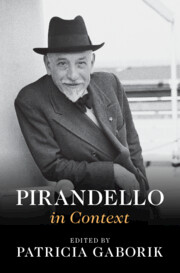Book contents
- Pirandello in Context
- Pirandello in Context
- Copyright page
- Dedication
- Contents
- Figures
- Contributors
- Preface
- Acknowledgments
- Chronology
- List of Cited Titles in Translation and the Original Italian
- Part I Places
- Part II Institutions
- Chapter 7 Publishing
- Chapter 8 Little Theatres
- Chapter 9 National Theatres
- Chapter 10 The Royal Italian Academy
- Part III Interlocutors
- Part IV Traditions and Trends, Techniques and Forms
- Part V Culture and Society
- Part VI Reception and Legacy
- Further Reading
- Index
Chapter 10 - The Royal Italian Academy
from Part II - Institutions
Published online by Cambridge University Press: 14 March 2024
- Pirandello in Context
- Pirandello in Context
- Copyright page
- Dedication
- Contents
- Figures
- Contributors
- Preface
- Acknowledgments
- Chronology
- List of Cited Titles in Translation and the Original Italian
- Part I Places
- Part II Institutions
- Chapter 7 Publishing
- Chapter 8 Little Theatres
- Chapter 9 National Theatres
- Chapter 10 The Royal Italian Academy
- Part III Interlocutors
- Part IV Traditions and Trends, Techniques and Forms
- Part V Culture and Society
- Part VI Reception and Legacy
- Further Reading
- Index
Summary
This chapter explores a key aspect of Pirandello’s relationship with the Fascist regime. In 1926, Benito Mussolini created the Royal Italian Academy (the Academy), to rival the prestigious national academies of other European countries such as France and Britain. Pirandello was the most famous appointee amongst the first thirty nominations of accademici in March 1929. The chapter traces Pirandello’s ambivalent attitude toward the Academy. On the one hand, he considered it just recognition of both his fame as an author and his early support of Fascism. On the other, he was skeptical of the usefulness of a national academy, especially if it bent to the will of the Fascist regime. The chapter reconstructs several episodes showing how Pirandello’s status as an accademico was related to his hopes of taking a leading role in the renewal of Italian theatre. His correspondence with his son Stefano and his confidant and muse Marta Abba reveals Pirandello’s low opinion of the rhetoric and emptiness of Fascist cultural policies, of which the Academy was a prime example.
Keywords
- Type
- Chapter
- Information
- Pirandello in Context , pp. 77 - 84Publisher: Cambridge University PressPrint publication year: 2024

